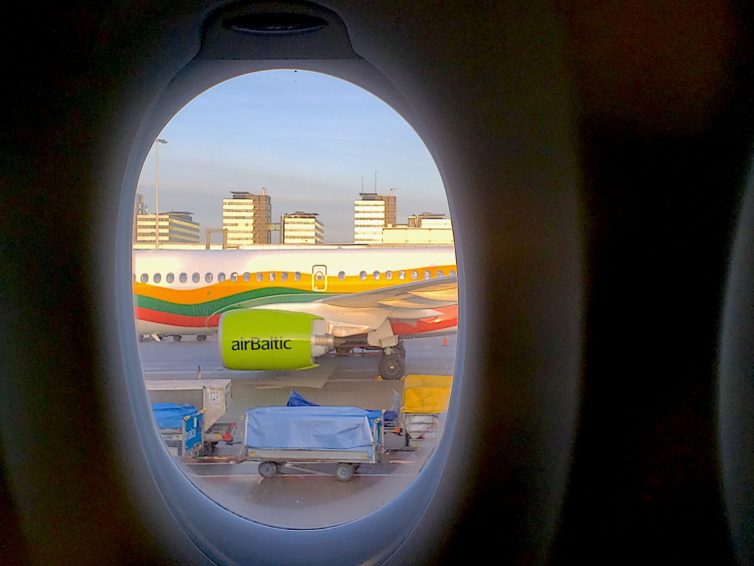
An airBaltic A220, with the Lithuanian flag livery. Photo: Jonathan Trent-Carlson
Just a few days ago, I published my experience flying in airBaltic’s economy class on my flight from Amsterdam (AMS) to Vilnius (VNO). After after some great adventures in Lithuania, I was ready to hit the skies again — but this time in the front of the (air) bus — I was flying in airBaltic’s Business Class. I was excited to see how it would compare to economy and see how a low cost carrier would handle a premium product.
The airBaltic check-in & lounge experience at VNO
Check-in at VNO was quick and easy. VNO does not have dedicated counter space for any one airline. Rather, overhead monitors display which check-in counter is for which airline at that time, and signage can be moved around.
After I had checked my bag and gotten through security, I wandered through a large section of duty free items before finding the lounge. The lounge was mostly empty, and I didn’t have much time. The lounge featured a self-service bar, with some wine, Lithuanian herbal liqueurs, and other spirits.
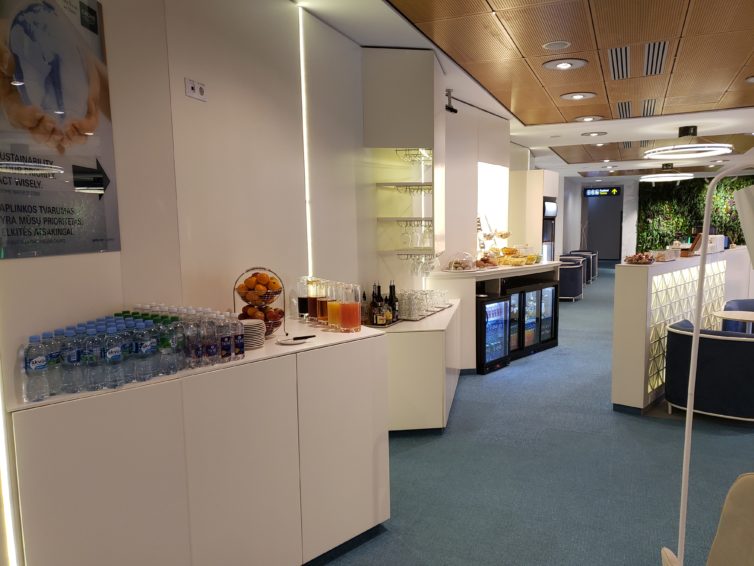
Beverages and breakfast pastries. A nice spread for this boutique lounge. Photo: Jonathan Trent-Carlson
There was a also a fancy coffee machine. At this early in the morning, I was not in the mood for alcohol but coffee was a must have. Specifically, coffee with two cubes of sugar.
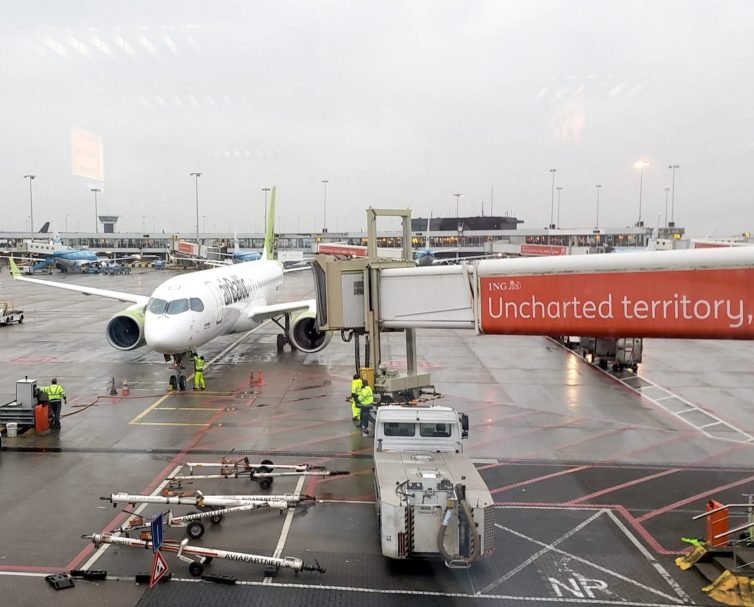
An airBaltic A220 pulls up to the gate at AMS. Photo: Jonathan Trent-Carlson
The advertisement on the jet bridge read “Uncharted Territory,” as an airBaltic Airbus 220-300 pulled in at Amsterdam’s Schipol Airport (AMS) in December of 2019. This was the plane that would be taking me into territory that was personally uncharted for me. First, I was flying to Vilnius (VNO), the capital of Lithuania, where I had never been. Second, it was a type of aircraft that I had never flown on before. Third, it was also on an airline that I had never flown before, airBaltic.
To Lithuania In Economy Class on airBaltic’s A220
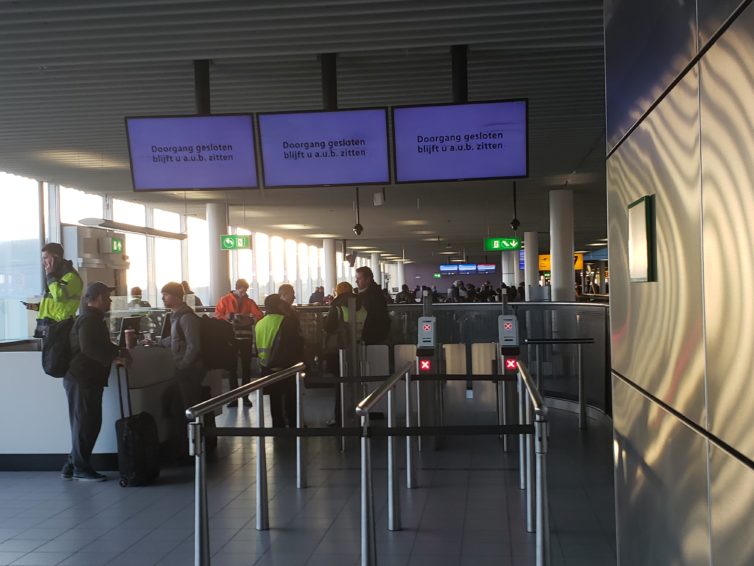
The boarding lanes prior to boarding. Photo: Jonathan Trent-Carlson
The boarding process at AMS involved lining up by fare class purchased, as displayed by overheard monitors. I lined up in the economy line, scanned my boarding pass, and walked down the jetway, towards uncharted territory. As I boarded the plane, I was struck by how spacious the cabin felt. At 6’2″, there was plenty of space for me to stand up.
The seats were arranged in a 3-2 configuration, similar to old McDonnell Douglas models. The windows were larger than those in preceding narrow body aircraft models. This allowed enough natural light into the cabin that the overhead lighting almost made no difference. The interior was mostly a light gray with neon green accents. Between the amount of natural light and the color scheme, the cabin gave off the feeling that you were almost in a modern day office.
I made my way past the first two rows, which were in the business class cabin, to row 14. Seat 14F was on my left, the side with three seats in the row. As it is an exit row seat, my bags had to go in the overhead bin rather than beneath the seat in front of me. AirBaltic equipped their A220s with Airbus’ Airspace bins, ensuring plenty of room for everyone’s carryon luggage. I put my bags in the bin and sat down.
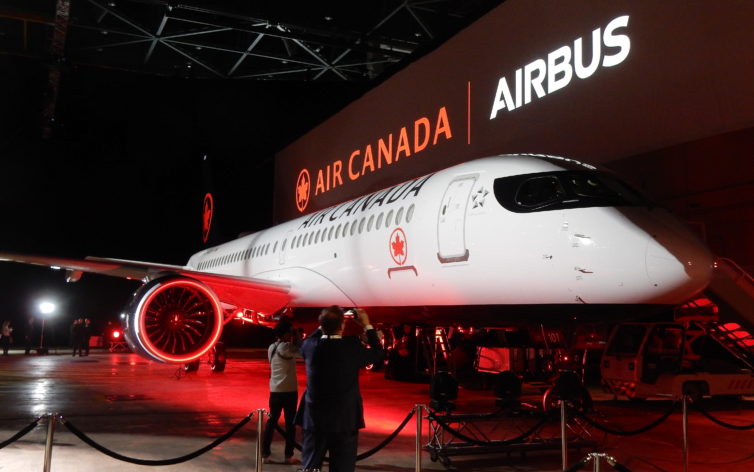
C-GROV, the first A220-300 operated by Air Canada – Photo: John Jamieson
On January 15th, North America’s fifth-largest airline became the newest operator of the Airbus A220. At Air Canada’s headquarters in Montreal, Fin 101 (C-GROV) was unveiled to employees, honored guests, and members of the media. Over the course of the event, we were able to go onboard the aircraft and take in the A220’s unique features. We also managed to interview Mark Galardo, Air Canada’s VP Network Planning.
With the focus of the event firmly on the aircraft (as opposed to a new destination), we’ve focused our analysis on the physical benefits. That said, we’ll have a thorough examination of the aircraft’s operational benefits, and our interview, in a future post. For now, follow along as we cover Fin 101 from nose to tail and explore every inch of Canada’s newest clean-sheet aircraft.
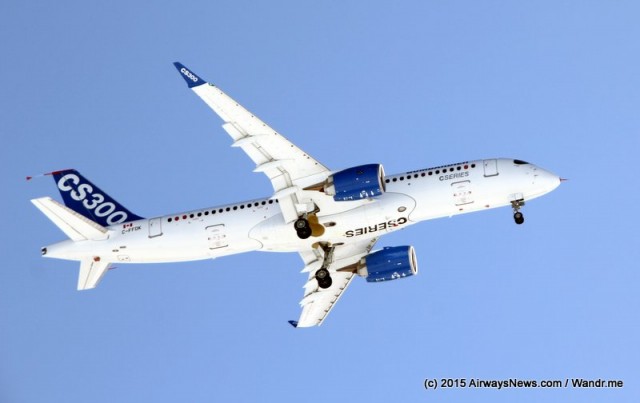
Bombardier CSeries CS300 takes flight for the first time – Photo: Seth Miller | AirwaysNews
The full story was written by Seth Miller on AirwaysNews.com.
The Bombardier CS300, the newest commercial aircraft on the market, made its maiden flight just after 11:00 a.m. yesterday at Montreal’s Mirabel airport. The larger CSeries variant follows the smaller CS100, which took to the skies 17 months ago.
For Bombardier, this is a significant step forward for a project which has seen its share of challenges. As a “clean-sheet’ aircraft design, such challenges are not unexpected; Boeing and Airbus experienced similar delays with the 787 and A350, respectively. Bombardier’s new CEO, Alain M. Bellemare, described the event as ’œan inflection point’ in the CSeries project, ’œwhere we’re finally reaching momentum and we can go to market with a solid product for our customers.’
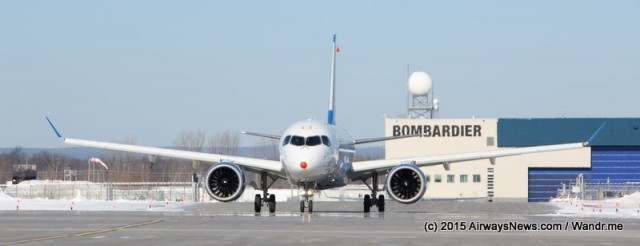
The first CS300 taxis – Photo: Seth Miller | Airways News
The test flight came on the second day of the three-day window Bombardier allotted for the event. Initial plans to run the test flight on Thursday were hampered by cold weather, wind, and snow earlier in the week in Mirabel; that weather prevented final pre-flight testing from happening. It was colder yesterday than earlier in the week ’“ probably the coldest first flight ever ’“ but the low temperatures did not prevent the first flight.
With both the CS100 and CS300 now flying, the company is able to aggressively push towards the completion of the flight test regimen and enter the airliner into service. It is also worth noting that the CSeries plan is somewhat unusual in having both types flying test flights concurrently rather than a sequential process of EIS on the first followed by testing of the second. Delays in the CS100 test program can be blamed in part for these circumstances.
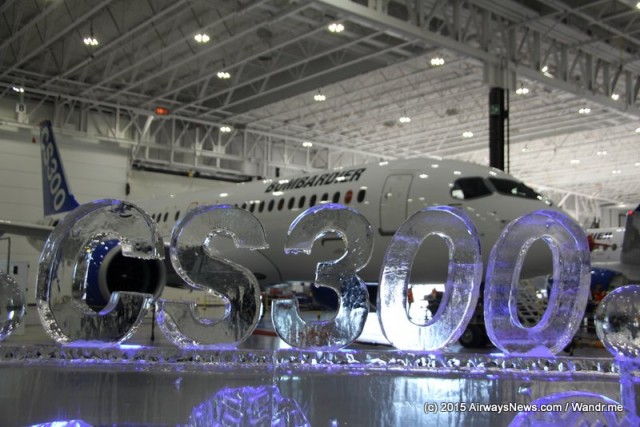
A special CS300 ice sculpture to celebrate the first flight – Photo: Seth Miller | AirwaysNews
The CSeries aircraft promises a more comfortable passenger cabin combined with lower costs for the airlines and quieter operations for the passengers and those who live near the airports. While the interior of the CS300 is not yet on display to media, the noise aspect was demonstrated during the first flight departure; the CRJ900 ’“ a quiet plane in its own right ’“ was notably louder than the CS300 flying just ahead of it during the first flight departure.
Continue reading Bombardier CSeries CS300 Achieves First Flight on AirwaysNews.com
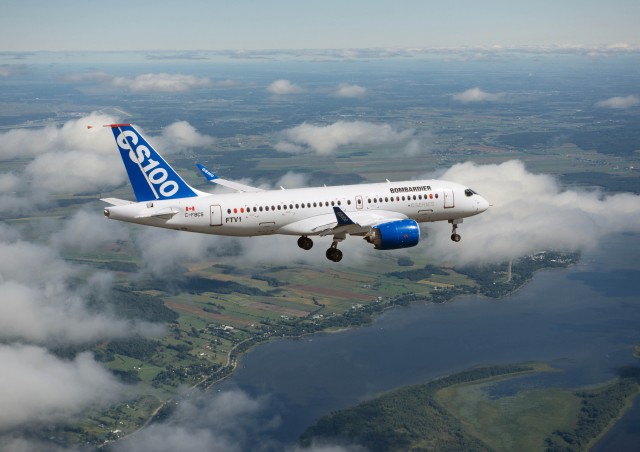
The CS100 during test flights – Photo: Bombardier
Bombardier’s in a bad way lately. Their stock has hit some heavy chop, recently dropping 32% in a three-day period. There’s a margin warning. The company is pricing in a “bankruptcy scenario”. On top of that, the stock fell 11% after they announced the removal of their troubled CEO.
The company is ridiculously leveraged. The cost of a credit default swap on Bombardier has risen 500 basis points. There are even serious questions regarding the company’s liquidity.
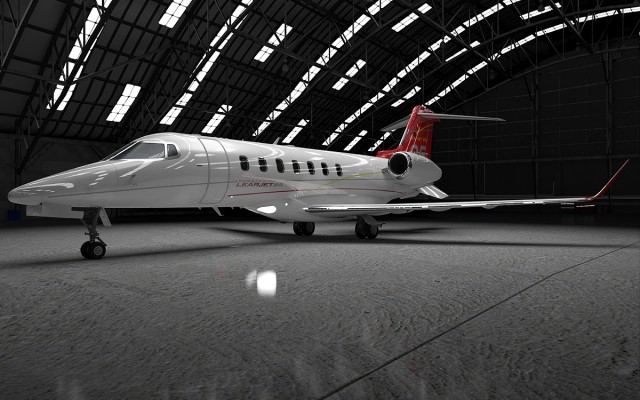
The Learjet 85 – Photo: Bombardier
This whole mess started when the company announced that it was “pausing” its advanced, composite, Learjet 85 for an indefinite period of time due to lack of demand. Now, canceling a business jet should not result in massive investor panic and questions over the viability of a commercial program. The problem is, Bombardier finances a lot of its projects off of the revenue generated by its business jet division and debt. The CRJ and Q400 program, along with trains, are relatively low margin.
There’s a reason investors are starting to, in the words of one firm “[give] up hope.”
Bombardier is suspending its shareholder dividends and working on raising an additional $2.1 billion in capital.
The thing is, in the paraphrased words of Richard Aboulafia at the Teal Group, these moves display a startling amount of intelligence and transparency. The question is, is it too late for Bombardier?









